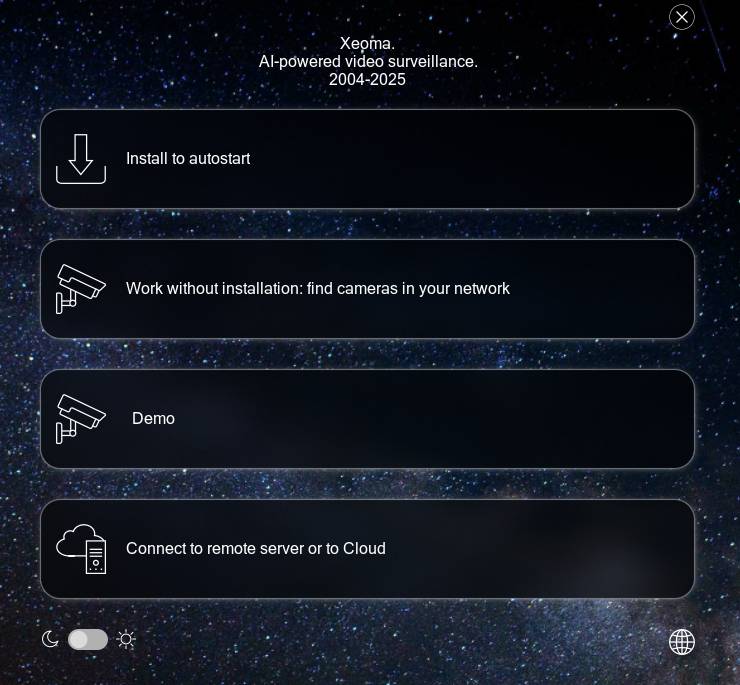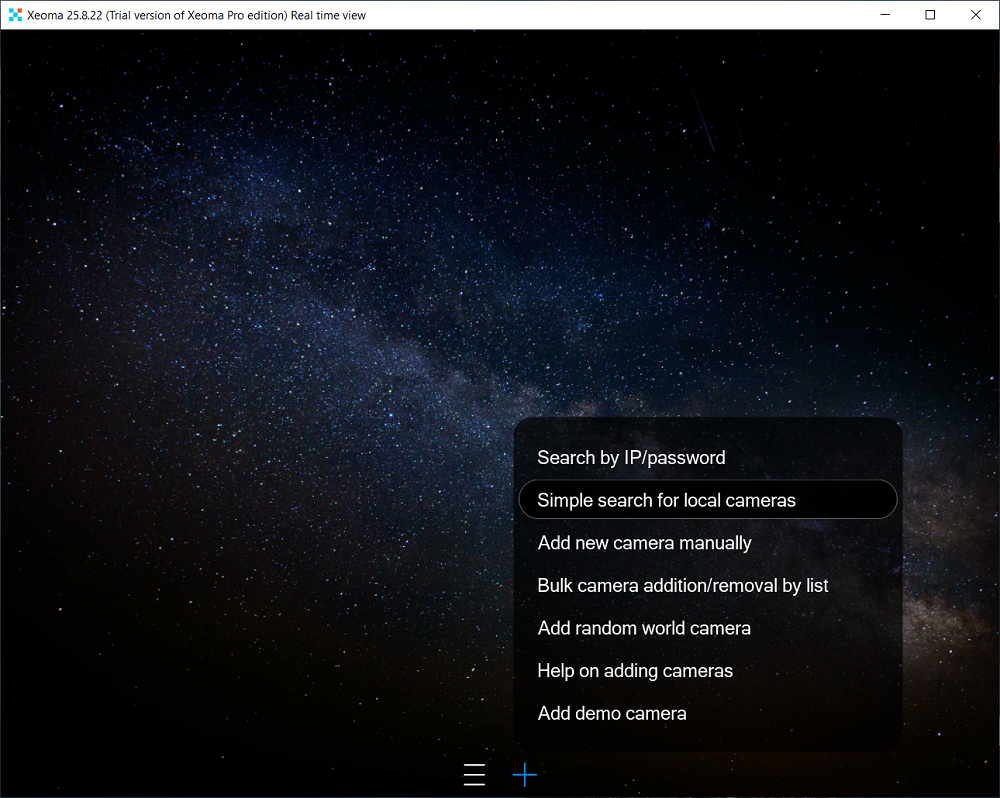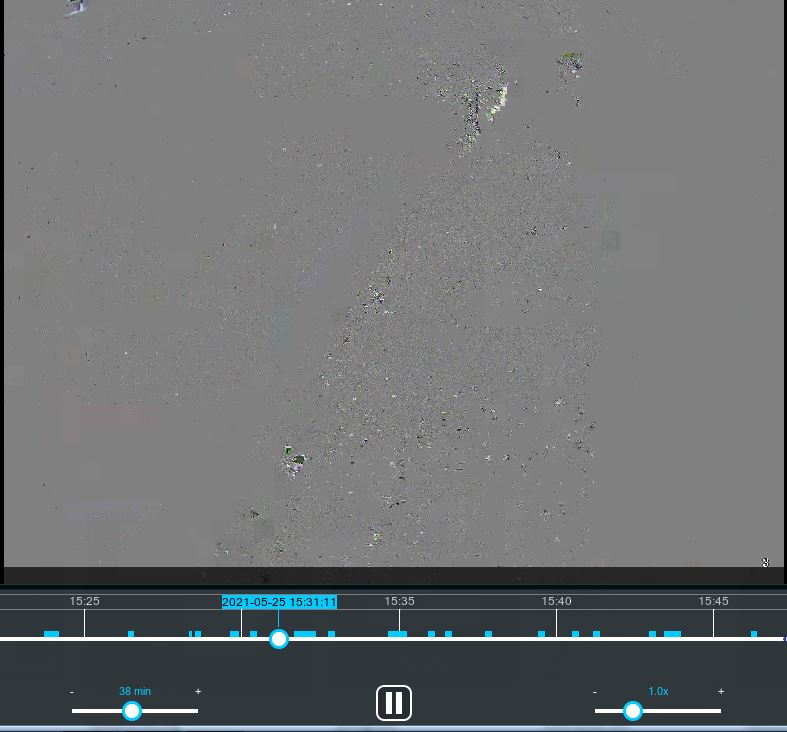
How to add cameras to Xeoma
Adding cameras to Xeoma and troubleshooting failed camera connection
Xeoma is the unique video surveillance software in many ways, one of which is its astonishing range of supported cameras. Xeoma supports 99% of cameras in the world, all types: USB, IP (network) cameras, analogue cameras and even a Raspberry camera module.
See camera requirements here
Xeoma is optimized for your convenience: cameras of any type can be added in the same way. Read on for a step-by-step guide on how to add cameras to Xeoma
![]() Please note that this guide is for regular Xeoma that works on your equipment. In case you’re interested in adding a camera to the Xeoma Cloud service, see another guide here instead.
Please note that this guide is for regular Xeoma that works on your equipment. In case you’re interested in adding a camera to the Xeoma Cloud service, see another guide here instead.
HOW TO ADD A CAMERA TO XEOMA
Part 1. Local cameras
Step 1. Download and launch Xeoma software. See a more detailed guide to this step here
Step 2. At its first launch, Xeoma displays the Welcome Window – a dialogue, where all options that may be useful for a user new to Xeoma are gathered.
Select the Work without installation: find cameras in your network option in this window to start Xeoma’s automated scanning for local cameras.

![]() The Welcome Window is only shown once, at the very first time you open Xeoma on a given computer, smartphone or tablet. Afterwards you can still find its options logically grouped in either the Main Menu (List icon) or the Add Menu (+ icon) in Xeoma’s bottom panel.
The Welcome Window is only shown once, at the very first time you open Xeoma on a given computer, smartphone or tablet. Afterwards you can still find its options logically grouped in either the Main Menu (List icon) or the Add Menu (+ icon) in Xeoma’s bottom panel.

Step 3. Xeoma will start its automated scanning for cameras in the home network and display a progress bar in its right bottom corner. Cameras found during this stage will be added to the main screen and start working right away.

Types of cameras that can be found with this fully automated search method:
- Wired USB cameras connected to this computer,
- Embedded cameras (laptop, smartphone, tablet, SmartTV cameras, etc.),
- Network cameras (IP cameras) in the same network,
- Analogue cameras connected to this computer via digitalization appliances.
These types of cameras are prioritized by the automated search, which means they are usually connected almost immediately (in the earliest 1-2% of the search progress bar):
- ONVIF: network (IP) cameras with ONVIF support, located in the same network,
- USB: USB cameras,
- Embedded cameras (laptop, smartphone, tablet, SmartTV cameras, etc.),
- Analogue cameras connected to this computer via digitalization appliances.
Other camera types like network cameras that have no ONVIF or camera emulation broadcasts will be found in the later stage of the automated search.
Once a camera is found, it will be added to the main screen – or put into the “+” menu in case of an overload.
Part 2. Remote cameras.
The simple automated search will not, however, find remote network cameras – ones that are located outside the home network of the computer that runs Xeoma.
Another, advanced search method should be used instead called Search By IP/Password.
To launch it, go to Xeoma’s Search Menu (+ icon) and select Search By IP/Password from its options.
Input the camera’s IP address or URL, credentials – as well as its port in case an unusual one is used.
Done! Your cameras will be discovered and connected to Xeoma.
Camera not found? See our Troubleshooting section for help
![]() You can also add cameras with a POST request or multiply cameras by duplication. Read more about these options in Xeoma User Manual Setup Guide, section 2.4. Auto scan and search for cameras.
You can also add cameras with a POST request or multiply cameras by duplication. Read more about these options in Xeoma User Manual Setup Guide, section 2.4. Auto scan and search for cameras.
Read also:
Camera video surveillance: choosing and connecting cameras
List of supported cameras
WHAT IF MY SURVEILLANCE CAMERA IS NOT AUTO-DETECTED IN VIDEOSURVEILLANCE PROGRAM XEOMA?
If the camera wasn’t detected
If camera image is distorted
If camera stream is intermittent
Low fps
What if my camera is not auto-detected in videosurveillance program Xeoma?
A brief guide, what you should do if your surveillance camera is not auto-detected.
For USB cams:
When working with USB web cameras in free video surveillance software Xeoma, you might get the ‘Not connected‘ error message. If so, please check if the camera is connected, or that the USB bandwidth of your USB hub is not exceeded.
-Does the surveillance camera work with other applications?
If it does not, check connection and camera’s drivers. If it does, go to the next question.
-For Windows or Linux OSes, is your surveillance camera in use right now?
Windows has restriction that USB cameras cannot be used by several applications simultaneously. Please turn off other applications that may be using your cam’s video stream to check it. If it is the case, you may want to consider using any video stream splitting utility (like SplitCam, ManyCam or similar) for all applications to be able to share the cam’s stream.
-Sometimes USB controllers are physically not capable of receiving image from several USB cams simultaneously. In this case you will need to plug each camera to separate controllers or use a controller that doesn’t have these issues. Using USB 3.0 or lowering down image resolution and image refresh rate in Xeoma until the USB capacity is enough to transmit image can also help.
For IP surveillance cameras:
Normally Xeoma auto-detects and plugs in all IP cams in network that are not protected with password or using standard default password and login information. Search starts automatically when you launch the program for the first time. Found cameras are automatically added to the screen or placed in the “+” menu in the panel below. To add the camera click on it.
If Xeoma didn’t auto detect your surveillance camera, use the “Search by IP/password” option ( in “+” menu). This way you will be able to search for a camera with specified access parameters (login, password, IP address / network, or port).
If it wasn’t of use, choose the “Add new camera manually” option in the “+” menu. Specify the URL for this camera in the corresponding field manually (Xeoma works with jpeg, mjpeg, mpeg-4, h.264, http and rtsp streams and PTZ.) To do that, copy cam’s URL (in browser or on admin page of the cam) and paste it in the respective box, along with password and login, if any.
Activation of the ONVIF protocol in the camera settings: If your camera supports ONVIF, make sure it is enabled in the camera’s admin page, as it may be disabled by default in many camera models. Try turning it on and running the auto search again.
May also help: For new models of ONVIF HikVision cameras: some cameras do not give access to streams to regular users, even administrator. In that case, you need to create an ONVIF user (you can use the same login/password) in Configuration -> Advanced Settings -> Integration protocol -> Add, and the stream will become available to Xeoma.
If that didn’t help, it is possible that the security settings of cameras have blocked access to cameras. Try to change these settings in camera admin pages to allow Xeoma to access them.
If all of the above does not work:
Make sure that the camera is connected and works (visible in other programs or browser).

|
Some cameras like Xiaomi Mi, NestCam, DropCam, Arlo, Victure, Reolink Argus Pro, Swann Super HD 5MP CCTV home security system, AXIS Companion, Netvue Vigil, new Zmodo camera models only work with their own software, not supporting any third-party software, including Xeoma. In such case, unfortunately, they can’t be connected to Xeoma. |
Please contact us and let us know your camera brand/model. Our experts will try to add a camera, if you send us
- camera’s external (!) IP address, user name and password
or
- id/password for TeamViewer (or similar program) connection to the computer where this camera can be viewed.
See also list of supported IP cameras in Xeoma (is constantly updated).

|
Read also: an extended guide ‘My IP camera is not found by Xeoma, what should I do?’
For questions about cameras in Xeoma Cloud, please see this page |
For analogue cameras:
Xeoma supports analog cameras connected through capture cards, TV tuners, DVRs, USB dongles, etc.
Make sure that your video capture card works with DirectShow/WDM drivers and has 1 chip per channel. Make sure that the cameras work in any other applications (better use standard utilities like Cheese for Linux and amcap for Windows). Xeoma works with default settings, so if something is not working the way you wanted, you need to change the defaults on your card/analogue surveillance camera.
If your analogue cameras are connected through a DVR, make sure the DVR works with MJPEG, JPEG, H264 or MPEG-4 streams and streams video through http or rtsp.
What if camera image is distorted in videosurveillance program Xeoma?

If you see gray or green distortions of camera image in Xeoma (also referred to as “ghosting” or “pixelation”), first of all please check that you don’t see the same in camera web admin page. If image is similarly distorted in camera web admin, the issue is on the camera side and should be resolved separately from Xeoma.
If however camera image is all right in camera web admin, yet distorted in Xeoma, such distortion usually appears if:
1) CPU load is too high
2) Network bandwidth is too low
3) Exceeded maximum connections limit to the camera
4) Wrong URLs
5) Bit rate is too high
1 and 2 – If you use multiple cameras, then try to use only one in Xeoma and see if distortion still appears. If not, then try to lower parameters (resolution and fps).
3 – Try to close camera in other programs as well as in browser
4 – You can check camera’s documentation to find the correct URL or internet. To find out if the URL is incorrect, you can play it in VLC player to see if it gets ‘laggy’ at the same time as it gets distorted in Xeoma. If it does, you should look for another URL (probably an MJPEG one) that doesn’t have such issues.
5 – Try to lower the bit rate (in camera’s web admin page).
Also you can try to set up the lowest resolution on preview (1st URL in ‘Universal camera’ module’s settings) for all cameras and see what happens. More here
Also, try different options in the “Data transfer method” setting in the “Universal Camera” module. One of them (TCP, UDP, Auto etc.) might help you get a more stable video stream.
If you see distortions like in “house of mirrors”, you might have probably enabled the Fisheye dewarping feature for this camera.
Go to settings of the “Preview and Archive” module for this camera, go all the way down to “Enable Fisheye dewarping” and untick it if it is ticked.
What if camera connection is intermittent in videosurveillance program Xeoma?
If your camera is connected all right in Xeoma, camera image is fine but connection to camera gets lost very often (every couple of seconds), you can do the following:
1) check your network capacity. Try to temporarily lower the camera stream’s bit rate, image resolution, fps to see if that helps.
2) check your network voltage. If the load is too high, this might also result in unstable work of all network equipment.
Stream in Xeoma gives lower fps than expected/set up in camera admin page
FPS can be a bit unstable, when H.264+ or H.265+ is used – this is due to the nature of the codec itself (the i-frames in it are spaced wider than in usual H.264). There are a few ways to improve it:
1) check the box Buffered video stream reading in the Universal camera module (N.B. this may result in additional delay)
2) uncheck the box Reduce the CPU load (decode only key frames) in the Universal camera module
3) try choosing different variants in Transport protocol type drop-down menu in the Universal camera module – they are network-sensitive
Unreliable streams
Sometimes Xeoma may display a message saying that the camera stream is unreliable and the image freezes. As a rule it happens because of network overload or due to an unstable connection to the network. In this case we recommend trying other options of available streams. To do this, go to the settings of the “Universal camera” module and find the Preview URL dropdown menu. Click on the down-arrow button and select another option that might be there in the list. See if it works better. If not, repeat with another stream line from the list
Frequently asked questions on how to connect cameras to Xeoma
1. How to find and add a camera in Xeoma automatically?
Either select the “Work without installation: find cameras in network” option in Xeoma’s welcome window that will be displayed upon the first launch, or use the simple search option from the search menu (“+” icon). Both ways you can help Xeoma scan the local network and find “local” cameras like IP cameras in the same network, USB or embedded cameras, analogue cameras connected to the computer Xeoma is running on. For information on how to add a remote camera, please read question 2. How to connect a remote IP camera in Xeoma?
2. How to connect a remote IP camera in Xeoma?
Xeoma’s simple search for cameras in the local network is not suitable for remote cameras. To connect remote cameras to Xeoma, you need to go to the “+” menu, select “Search by IP/password”, and manually enter the camera stream’s IP address and port, as well as login and password (if any).
3. Why doesn’t Xeoma find an IP camera automatically, and how to fix it?
“Local” cameras should be found with Xeoma’s simple search. If such a camera is not added to the main screen, see if it’s listed in the “+” menu.
To connect a remote camera, try the “Search by IP/ password” option in the “+” menu instead, where you can input more significant information about the camera – like it’s URL or IP address.
For ONVIF-compliant cameras, ensure the ONVIF protocol is enabled in the camera settings and an ONVIF user has been created (relevant for HikVision cameras).
Alternatively, you can add a network camera to Xeoma manually: find the exact stream URL (in the Internet, camera documentation, or the camera web interface) and add it with the “Add new camera manually” option in the “+” menu.
4. What to do if Xeoma doesn’t see a USB camera or says “Not connected”?
Check if the camera is actually connected to the computer and is working. Update the camera’s drivers. Ensure the camera is not occupied by another application (especially in Windows) or use stream-splitting software like SplitCam. Also, check the USB controller’s bandwidth: try to insert the camera cord into another USB port or disconnect other USB devices temporarily.
5. Which surveillance cameras are not supported by Xeoma?
Xeoma does not work with cameras that use closed proprietary software or clouds. These include Xiaomi Mi, NestCam, DropCam, Arlo, Victure, Reolink Argus Pro, Ezviz H8c, Reolink Go and other battery-powered Reolink cameras, Swann Super HD 5MP CCTV home security system, AXIS Companion, Netvue Vigil, Tuya (FUERS), new Zmodo models, SoloCam S340, and some Chinese “no name” cameras that lack a web interface or require third-party plugins (like ActiveX).
6. Why is the camera image in Xeoma gray, green, or distorted?
Possible causes include high CPU load, a weak network, or an incorrect URL. Solution: lower the resolution/bitrate, leave only one camera for testing, or change the protocol type (TCP/UDP) in the “Universal Camera” module settings.
7. What to do if the camera video lags or has low FPS?
The issue is often related to H.264+/H.265+ codecs. Try to enable “Buffered reading of video stream”, disable “Lower CPU load” or change the protocol type (TCP/UDP) in the “Universal Camera” module settings.
8. Why does the camera picture constantly disappear or freeze?
The “unstable stream” message is often caused by network congestion or network equipment issues. It is recommended to check on your network equipment or select a different stream from the “Stream for preview” drop-down list in Xeoma’s “Universal Camera” module settings.
4 September 2012
Last update: 18 December 2025
Read also:
Frequently Asked Questions about Xeoma software
Camera video surveillance: choosing and connecting cameras
Complete Xeoma User Manual